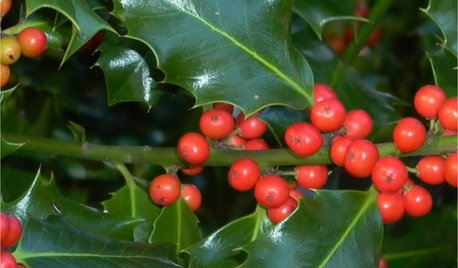Hornworms Are Good For the Garden!
susanlynne48
17 years ago
Featured Answer
Sort by:Oldest
Comments (18)
rjj1
17 years agolast modified: 9 years agoOkiedawn OK Zone 7
17 years agolast modified: 9 years agoRelated Discussions
Good Gardens make good neighbors
Comments (4)Thanks, idig. Except for the smaller "trimming" plants such as the salvia and rosemary, maybe the roses if they like being transplanted, the "after" will really take a couple of years to look good. The Italian cypress and boxwood are more structural plantings which must mature to give their intended effect. And th row of plants on the SOUTH border, well, I am much more comfortable with these tropicalesque types. They grow very quickly to become massive, and will screen our side sunporch very nicely from traffic coming up the street. Those old azaleas did screen that exposure, but mercy they were ragged and dead in the middle. The ones I cut back last year are ready to bloom this year. Our cross-street neighbor brought over another rose for us to plant, her third such gift. The first one she gave me is now tall and graceful with new red leaves and beaucoup of buds getting fat and tinged with deep red. Many people are cheerful givers, like my husband, but do not know how to receive graciously. When folks do not have much to give, accepting their offering becomes magnified in importance. It would be easy to say, "I don't need that in my garden," like her latest offering of thornless blackberries, but giving her a place in our garden seems the thing to do. She has bad health, cannot work in the yard any more, yet each spring she gets the itch to plant something. I hope someone does the same for me in a few years....See MoreOctober 2012 garden updates: what looks good/awful in your garden
Comments (22)That's awesome euqruob! What do you do with them? Are they fruit like or veggie like? I'd love to see/hear more! It's cool for sure! Here's a rescue adenium that I picked up for just a couple of bucks early this year. It was terribly abused and had gotten stuck in the holes of its cheap plastic pot. No leaves, no blooms, and virtually no soil. Now it's got a ton of leaves (and a nice pot after I cut away the old plastic one) and blooms. I really like the peppermint look of the fancy double flowers! Here's some Merremia dissecta ("Alamo vine" or "mile a minute vine") that I got as seeds from old Mr. Baker at Baker Nursery years ago. This spring I planted three seeds at the base of this 6 foot tall iron obelisk/armillary and they have quickly consumed it. Talk about house-eaters! The vines are covered early summer through very late autumn with nice morning-glory-like blooms that stay open well into the afternoon. Full, hot sun (yes even here) and fairly regular irrigation keep these vines looking great, and blooming. Take care and happy gardening! Keep the fun updates coming! Grant Here is a link that might be useful: Pics, so far, from my garden, October 2012...See MoreGood Gardener/Bad Gardener
Comments (3)I dunno if it fits the mold, but our neighborhood has 'Sam", a salt of the earth type in his mid-80's, the same one who plants an acre of onions. Sam has a 1940's vintage Massey Ferguson tractor, in the condition of what one would expect. Brakes a long faded memory, an old blue-jeans pillow for the seat, baling wire, heavier wire, and rust. Sam loves to come along in the spring and plow you garden, when he plows his. Then, when he wants to disc his place, he'll disc yours. Then, when he wants to till his, he'll till yours. Thus, the whole neighborhood follows his planting schedule. Driving around the neighborhood, you will find that everybody's vegetable garden is now surrounded by a fence or somehow made tractor-inaccessable. Sam is a firm believer in moon phase planting, and will get rather theatrical in his description of what the moon phase has to do with cabbages and human digestion. He does have some interesting observations with this, re brine level in large (25 gal) sauerkraut crocks and moon phase which pass the '52 'what the heck, let me see if its true' test. I have found that if I follow along, I find a wonderfully generous neighbor who will show up with truck loads of manure, and this past fall, he swung by with a few hundred empty plant pots from Walmart, where he works....See MoreTomatoes, potatoes and pesky hornworms
Comments (7)moms helper Your maters and taters look great!! I also grew Delicious along with others including Brandy wine. I was lucky with THW I only had a couple. I spray with Surround. I assume you are in the same or close climate zone judging by the maturity and date of post. I am in what I call zone 5 / 6 . I try to seperate my early maters from my lates to help stop the continuation of early blight into late blight. The surround seems to help this also. The ghostly appearance doesnt bother me. While I am at it I would like to correct something I said in another Tomato Hornworm Discussion. I am sure you folks know that the Tomato horn worm does not turn into a humming bird moth.I read this in an insect book. This is not true. The Humming bird moth is a Sphinxe moth but not the same as the THW moth.Have you ever tried the " 4th of july " tomato? golf ball size and very tasty. Happy Gardening Johnny...See Morerjj1
17 years agolast modified: 9 years agoOkiedawn OK Zone 7
17 years agolast modified: 9 years agosusanlynne48
17 years agolast modified: 9 years agoOkiedawn OK Zone 7
17 years agolast modified: 9 years agopeachymomma
17 years agolast modified: 9 years agosusanlynne48
17 years agolast modified: 9 years agoilene_in_neok
17 years agolast modified: 9 years agoOkiedawn OK Zone 7
17 years agolast modified: 9 years agomulberryknob
17 years agolast modified: 9 years agosusanlynne48
17 years agolast modified: 9 years agoOkiedawn OK Zone 7
17 years agolast modified: 9 years agoKd VM
2 years agoAmyinOwasso/zone 6b
2 years agoKd VM
2 years agoKd VM
2 years ago
Related Stories

LANDSCAPE DESIGNGood Fences, Good Neighbors — and Good Views
See-through vertical fencing connects a yard with its surroundings while keeping children and pets safely inside
Full Story
GARDENING AND LANDSCAPINGBid Bad Garden Bugs Goodbye and Usher In the Good
Give ants their marching orders and send mosquitoes moseying, while creating a garden that draws pollinators and helpful eaters
Full Story
GARDENING FOR BUTTERFLIESGardening for the Bees, and Why It’s a Good Thing
When you discover how hard bees work for our food supply, you may never garden without them in mind again
Full Story
FARM YOUR YARDHow to Get Good Soil for Your Edible Garden
The nutrients in your soil feed the plants that feed you. Here are tips on getting it right — just in time for planting season
Full Story
NATIVE PLANTS5 Ways to Keep Your Native Plant Garden Looking Good All Year
It’s all about planning ahead, using sustainable practices and accepting plants as living organisms
Full Story
LANDSCAPE DESIGNHow to Look Good From Any Angle (the Garden Edition)
Does your garden pique interest from one vista but fall flat from another? These tips and case-study landscapes can help
Full Story
GARDENING GUIDESThe Surprising Ingredients Every Good Garden Should Have
See what to do — and not do — for lasting rewards in your landscape
Full Story
EDIBLE GARDENSGrow Herbs for Fresh Flavor and Good Looks in the Garden
With sun and a patch of ground, you can have all the fresh flavor you need for cooking right outside your door. Here's how to get started
Full Story
GARDENING GUIDES9 Holly and Ivy Plants for Good Tidings in the Garden
Spread Christmas joy all year round with the gorgeous foliage and bright berries of these evergreen plants
Full Story
PATIOSPatio Details: Good-bye Cracked Concrete, Hello Lush Garden
A San Francisco couple replace an old parking space with a barefoot-friendly outdoor retreat for eating, entertaining and play
Full StorySponsored



AmyinOwasso/zone 6b